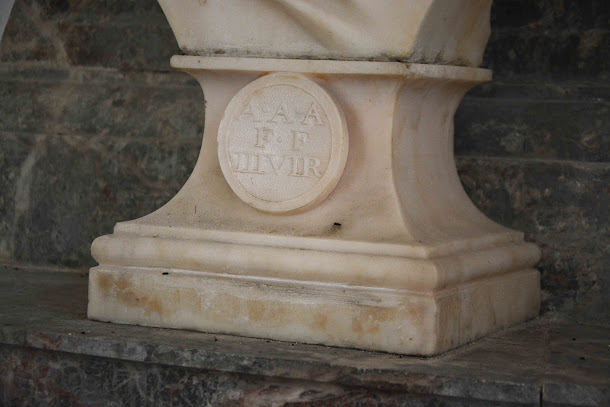Post under construction.
some notes -
To my knowledge no one has looked closely at the form of the socles used by Roubiliac on his portrait busts.
Malcolm Baker has written about the backs of mid 18th century portrait sculpture, with particular reference to the busts in the Library at Trinity College, Dublin but little has been said about the socles
Fourteen ancient and modern worthies which form a distinct set. In 1743 a sum of £500 was bequeathed by Dr Claudius Gilbert, the Vice-Provost, 'for the purchase of busts of men eminent for learning to adorn the library'.
Some at least of these must have been in place by March 1749, when it was reported that Roubiliac's bust of Swift, which was not acquired out of the Gilbert funds, was 'to be placed in the College Library, among the heads of other men eminent for genius and learning'
The Shakespeare bust is fully signed 'Peter Scheemakers', and seven others - Usher, Homer, Demosthenes, Cicero, Milton, Locke, and Pembroke - are signed 'P.S.Ft.
Perhaps I'm being unkind but I have a little trouble with the Trinity Dublin busts which have long been attributed to Roubiliac - certainly they are extremely competent but except for the bust of Jonathan Swift, they lack the flare of Roubiliac's major works - I suspect that although probably subcontracted to Roubiliac by Scheemakers they are the product of his workshop - my suspicion falls on John van Nost III (c. 1713 - 1780). (apprenticed to Henry Scheemakers in 1726.
John van Nost was working in Dublin from at least 1749 - I believe they are too early for the Irish sculptor Patrick Cunningham (fl. 1758 - 1774).
More work needs to be done on van Nost and his early career and his relationship with Roubiliac prior to his emigrating to Dublin.
see - https://staging.burlington.org.uk/media/_file/generic/886825.pdf
..............
The Socles on the Busts by Roubiliac at Wilton House.
with the rondels on the front.
Martin Folkes.
Wilton House.
....................
Sir Andrew Fountaine
Wilton House.
.................
The socle with the rondel on this bust had unfortunately been turned to face the wall making it rather difficult to get a good photograph
....................
Paul Whitehead (1710 - 74).
Marble Bust.
West Wycombe Park.
attributed to Roubiliac by Mrs Esdaile.
A portrait by Gainsborough was engraved by Collyer in 1777 and by Rolls in 1821, when in the possession of a Mrs Morris. John Michael Williams exhibited a painting of Whitehead at the Free Society of Artists in 1762 (1), but its whereabouts is also unknown.
The sitter was sculpted by Roubiliac; two versions were in the sculptor's posthumous sale, 12-15 May, 1742, being lots 14 of the first day and 15 of the third day
A mould for these busts was also sold Lot 63 Day 2. to my
knowledge no plaster bust of Paul Whitehead has yet been discovered.
An engraving by an unknown
artist depicts Whitehead in profile and reproduces the memorial verses on the
urn containing his heart at West Wycombe Church.
Mrs Esdaile attributed a bust at West Wycombe to him which
Paul Whitehead?
Plaster Bust.
Possibly Roubiliac.
Anonymous Sale Christie's Lot 142 4 July 1989
https://photoarchive.paul-mellon-centre.ac.uk/objects/406662/paul-whitehead
........................................
Lord Ligonier.
Drawing by Joseph Nollekens.
One of seven drawings of the Roubiliac Busts.
This is probably of a plaster - the marble in the Royal Collection which now has a turned socle would have originally had an unusual carved socle as seen in the Aquatint of the staircase well at Carlton House showing the two busts with their original socles in Pyne's Royal Residences, 1819. Engraved by Thomas Sutherland after Charles Wild. Published by: W. H. Pyne, 36 Upper Charlotte Street, Fitzroy Square.
Harris Museum, Preston.
For the Harris Museum Drawings of the Roubiliac Busts by Nollekens see
For a fairly thorough look at the busts depicted in these drawings -
https://bathartandarchitecture.blogspot.com/2023/07/the-harris-museum-preston-drawings-of.html
These drawings are fairly safely attributed to sculptor Joseph Nollekens
(1737 - 1823).
Hayward noted his arrival in Rome with Jiacomo Freys son on 11 August - a droll account of his journey survives in a copy of a letter written to sculptor Thomas Banks (1735 - 1805), see Whitley 1821 - 37.
The original Socle of the bust of George III in the Royal Collection which was paired with the bust of Lord Ligonier as seen in the Pyne Aquatint.
.....................
The socle appears on the busts of Sir Andrew Fountaine at Wilton House, and on the Fountaine monument in Narford Church, Norfolk (below).














No comments:
Post a Comment